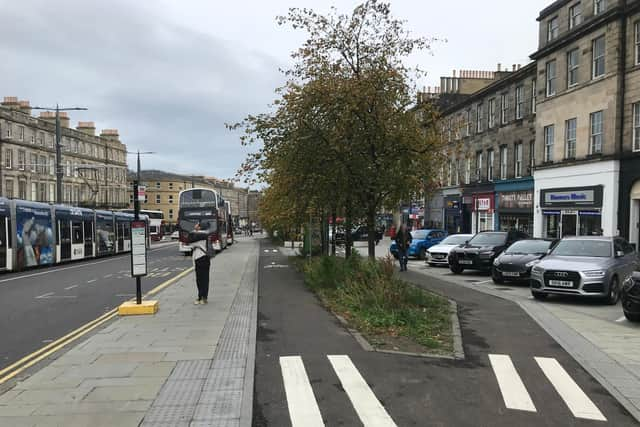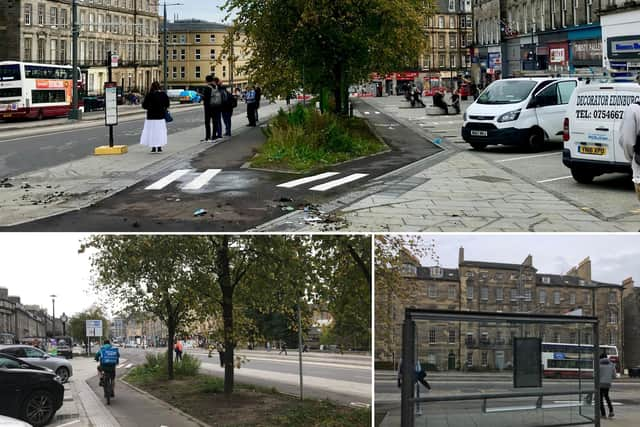Edinburgh’s Elm Row bus stop ‘galling’ design puts pedestrians and cyclists in conflict transport groups say
and live on Freeview channel 276
Edinburgh transport groups have expressed disappointment at a bus stop design on Elm Row, saying the layout puts pedestrians and cyclists in conflict with each other.
Living Streets Edinburgh, Edinburgh bus users group (EBUG) and Spokes along with community councils have questioned the design for two years, raising concerns that a cycle lane situated in front of a bus stop was at odds with safety.
Advertisement
Hide AdAdvertisement
Hide AdWhilst other ‘floating bus stop’ designs route cyclists behind a bus shelter, the bus stop in question by campaigners incorporates two cycle lanes, with the northbound cycle lane situated in front of the bus stop and the southbound cycle lane located beside the Elm Row car park.


Living Streets Edinburgh previously criticised the design for reducing pedestrian space and said the cycle lanes that run both north and southbound were confusing. David Hunter, convener of the Living Streets Edinburgh Group described the design as ‘galling’ adding the design of the cycle paths only allows for a ‘tiny pavement at the very busy bus stops.’
Across 2021 and 2022, EBUG joined other transport groups to campaign for ‘a more thoughtful and safer public realm design at Elm Row’ with group secretary, Chris Day noting this design was ‘particularly problematic.’
Mr Day said: “Now we actually see the design implemented and little or nothing has changed and you can see it’s totally unsatisfactory. The cycle lane is right in front of the bus shelter, so if you are waiting for a bus you are forced to walk across the cycle lane.”
Advertisement
Hide AdAdvertisement
Hide AdMr Day added that the seven-metre distance from the bus shelter to the bus loading area made it more difficult for people with mobility issues and he expects there to be a conflict between pedestrians and cyclists who will be uncertain who has priority.
![EBUG secretary, Chris Day said: “Our view is that the priority throughout [the tram project] has been to complete the project on time and on budget and in doing so have completely overlooked the needs of bus users along the route. To put a cycle path in front of the bus stop is absolutely daft”](https://www.edinburghnews.scotsman.com/webimg/b25lY21zOmRjZTA1NGQ1LTdkNGItNGU4OC1iYjgyLTczZjlhMjhhYmYyOToxZGViZWIxMy0xNmRhLTQzMTAtYTk2YS05MTVjMzA5MTFlNzI=.jpg?crop=3:2,smart&width=640&quality=65)
![EBUG secretary, Chris Day said: “Our view is that the priority throughout [the tram project] has been to complete the project on time and on budget and in doing so have completely overlooked the needs of bus users along the route. To put a cycle path in front of the bus stop is absolutely daft”](/img/placeholder.png)
Alex Robb, a member of cycling campaign group Spokes said they raised concerns over the design in late 2021 and along with other groups offered ‘deliverable alternative options’ that would have located both cycle lanes away from the pavement but believes ‘space has been given over to car parking.’
Mr Robb said that by incorporating a parallel car parking space design instead of a sloping echelon layout, there would be ample space for a two-way cycle track that travels a further distance from the bus stop.
He said: “That would resolve a huge amount of that conflict because it would mean there wasn’t a cycle lane directly in front of the bus shelter. That was the main call all the groups were looking for right the way through from the start of the public consultation early 2022. We were hoping to find some sort of compromise there and it’s a real shame that that wasn’t taken because it’s meant that there is not much space near the bus stops. It’s not as if the alternative was no parking and no loading, it just would have meant less parking, but it would have created a far better pedestrian and cycling experience.”
Advertisement
Hide AdAdvertisement
Hide AdHe added: “We absolutely support floating bus stops, they are safe and used across the world, but they need to be designed as well as possible and that hasn’t been done here. Pavement space really is at a premium there so anything to improve that and reduce conflict between pedestrians and cyclists is really important.”


Councillor Scott Arthur, transport and environment convener, said: “I understand the new layout on Elm Row is as was intended, compliant with the version of the Edinburgh Street Design Guidance used at the time.
“I acknowledge, however, that there are some concerns about the design. I have therefore asked council officers to set up a meeting with the Edinburgh Access Panel, Living Streets, Spokes, Edinburgh Bus Users Group and the local community council with the aim of identifying any conflicts with the sustainable transport hierarchy.”
Comment Guidelines
National World encourages reader discussion on our stories. User feedback, insights and back-and-forth exchanges add a rich layer of context to reporting. Please review our Community Guidelines before commenting.